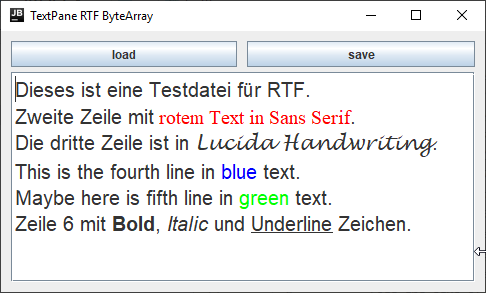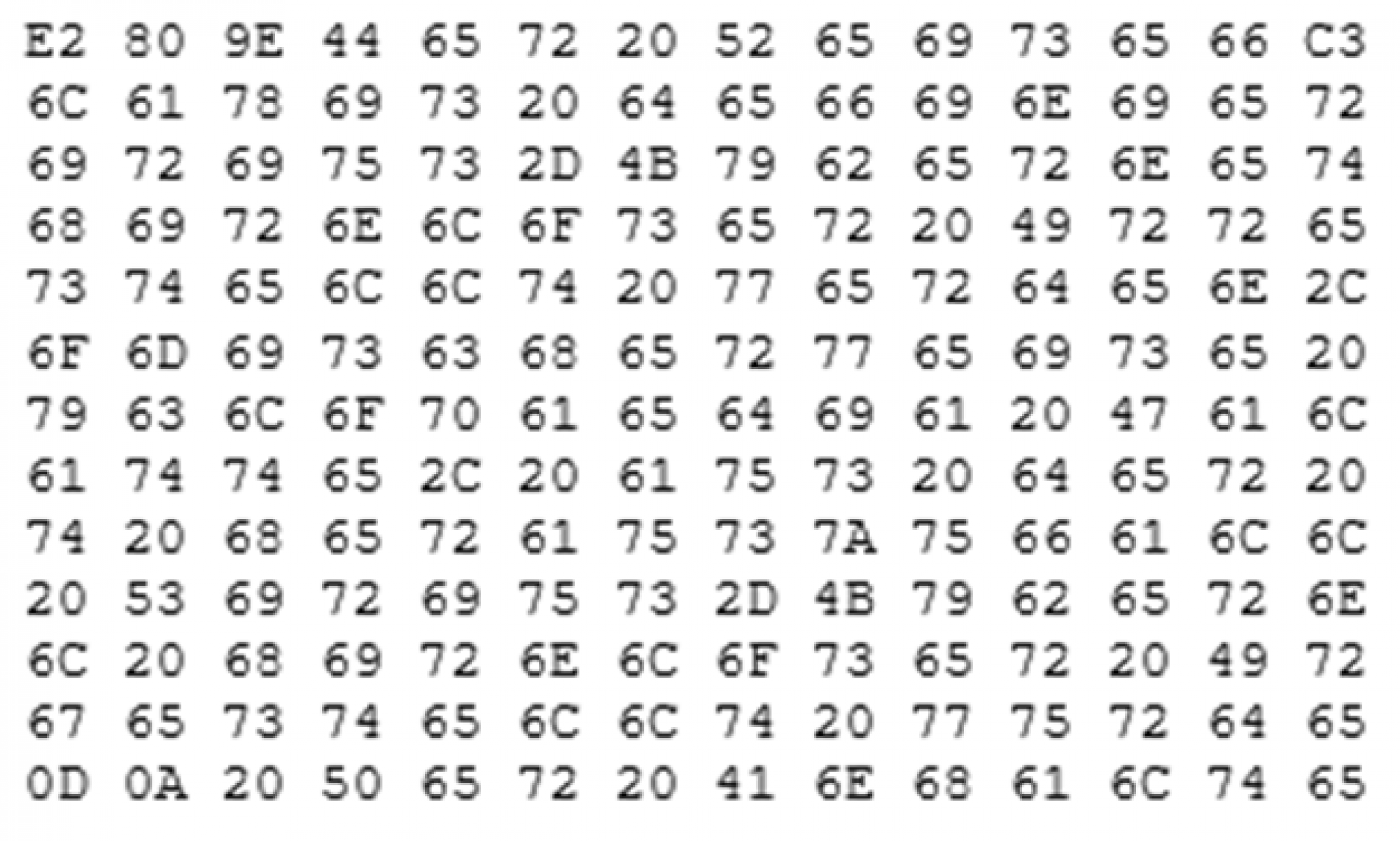Die Nutzung der JTextPane-Komponente entstammt einem Kryptografie-Projekt. Nahezu alle Verschlüsselungsroutinen benötigen als Eingangs- und Ausgangsformat ein ByteArray und sind damit für die direkte Verbindung zu einer JTextPane nicht nutzbar.
Dieses Beispiel zeigt Euch auf, wie Ihr den Inhalt eines JTextPane in ein ByteArray übertragt und dieses dann („noch“) unverschlüsselt in eine Datei schreibt. Die Laderoutine lädt die Datei zuerst in ein ByteArray und überträgt dieses dann ins das JTextPane.
Das Beispiel ist nur in intelliJ IDEA lauffähig. Hier ein Screenshot des Programms, die Testdatei ist unter diesem Link textpane_rtf.rtf ladbar.

Der Quellcode des Programms:
|
1 2 3 4 5 6 7 8 9 10 11 12 13 14 15 16 17 18 19 20 21 22 23 24 25 26 27 28 29 30 31 32 33 34 35 36 37 38 39 40 41 42 43 44 45 46 47 48 49 50 51 52 53 54 55 56 57 58 59 60 61 62 63 64 65 66 67 68 69 70 71 72 73 74 75 76 77 78 79 80 81 82 83 84 85 86 87 88 89 90 91 92 93 94 95 96 97 98 99 100 101 102 103 104 105 106 107 108 109 110 111 112 113 114 115 116 117 118 119 120 121 122 123 124 125 126 127 128 129 130 131 132 133 |
/* * Herkunft/Origin: http://java-crypto.bplaced.net/ * Programmierer/Programmer: Michael Fehr * Copyright/Copyright: frei verwendbares Programm (Public Domain) * Copyright: This is free and unencumbered software released into the public domain. * Lizenttext/Licence: <http://unlicense.org> * getestet mit/tested with: Java Runtime Environment 11.0.5 x64 * verwendete IDE/used IDE: intelliJ IDEA 2019.3.1 * Datum/Date (dd.mm.jjjj): 30.12.2019 * Funktion: TextPane RTF ByteArray = * laden und speichern einer RTF-Datei über eine ByteArray * Function: TextPane RTF ByteArray = * load and save of a rtf-file via a ByteArray * * Hinweis/Notice * Sie benoetigen intelliJ um das Programm uebersetzen und ausfuehren zu koennen * You need intelliJ to build and run the program */ import javax.swing.*; import javax.swing.text.BadLocationException; import javax.swing.text.DefaultStyledDocument; import javax.swing.text.StyleContext; import javax.swing.text.StyledDocument; import javax.swing.text.rtf.RTFEditorKit; import java.awt.event.ActionEvent; import java.awt.event.ActionListener; import java.io.*; import java.nio.file.Files; import java.nio.file.Path; import java.nio.file.Paths; public class TextPane { private JPanel panelMain; private JPanel panelButtons; private JButton buttonLoad; private JScrollPane scrollPane; private JTextPane textPane; private JButton buttonSave; byte[] arrayUncrypt = null; public TextPane() { textPane.setContentType("text/rtf"); textPane.setEditorKit(new RTFEditorKit()); buttonLoad.addActionListener(new ActionListener() { @Override public void actionPerformed(ActionEvent actionEvent) { loadRtfByteArray("textpane_rtf.rtf"); } }); buttonSave.addActionListener(new ActionListener() { @Override public void actionPerformed(ActionEvent actionEvent) { saveRtfByteArray("textpane_rtf.rtf"); } }); } public static void main(String[] args) { JFrame frame = new JFrame(); frame.setContentPane(new TextPane().panelMain); frame.setDefaultCloseOperation(JFrame.EXIT_ON_CLOSE); frame.pack(); frame.setTitle("TextPane RTF ByteArray"); frame.setSize(500, 300); frame.setVisible(true); } public void loadRtfByteArray(String filename) { arrayUncrypt = readBytesFromFileNio(filename); RTFEditorKit RTF_KIT = new RTFEditorKit(); textPane.setContentType("text/rtf"); InputStream inputStream; try { inputStream = new ByteArrayInputStream(arrayUncrypt); final DefaultStyledDocument styledDocument = new DefaultStyledDocument(new StyleContext()); RTF_KIT.read(inputStream, styledDocument, 0); textPane.setDocument(styledDocument); // delete added last line String content = textPane.getDocument().getText(0, textPane.getDocument().getLength()); int lastLineBreak = content.lastIndexOf('\n'); textPane.getDocument().remove(lastLineBreak, textPane.getDocument().getLength() - lastLineBreak); } catch (IOException | BadLocationException e) { e.printStackTrace(); } textPane.requestFocus(); } public void saveRtfByteArray(String filename) { // diese routine überträgt den inhalt eines JTextPane in ein byteArray ByteArrayOutputStream out = new ByteArrayOutputStream(); RTFEditorKit kit = (RTFEditorKit) textPane.getEditorKit(); StyledDocument doc2 = textPane.getStyledDocument(); int len = doc2.getLength(); try { kit.write(out, doc2, 0, len); arrayUncrypt = out.toByteArray(); } catch (IOException e) { e.printStackTrace(); } catch (BadLocationException e) { e.printStackTrace(); } try { out.close(); } catch (IOException e) { e.printStackTrace(); } writeBytesToFileNio(arrayUncrypt, filename); } private static void writeBytesToFileNio(byte[] byteToFileByte, String filenameString) { try { Path path = Paths.get(filenameString); Files.write(path, byteToFileByte); } catch (IOException e) { e.printStackTrace(); } } private static byte[] readBytesFromFileNio(String filenameString) { byte[] byteFromFileByte = null; try { //bFile = Files.readAllBytes(new File(filenameString).toPath()); byteFromFileByte = Files.readAllBytes(Paths.get(filenameString)); } catch (IOException e) { e.printStackTrace(); } return byteFromFileByte; } } |
Die XML-Datei von TextPane.form:
|
1 2 3 4 5 6 7 8 9 10 11 12 13 14 15 16 17 18 19 20 21 22 23 24 25 26 27 28 29 30 31 32 33 34 35 36 37 38 39 40 41 42 43 44 45 46 47 48 49 50 51 52 |
<?xml version="1.0" encoding="UTF-8" ?> - <form xmlns="http://www.intellij.com/uidesigner/form/" version="1" bind-to-class="TextPane"> - <grid id="27dc6" binding="panelMain" layout-manager="GridLayoutManager" row-count="2" column-count="1" same-size-horizontally="false" same-size-vertically="false" hgap="-1" vgap="-1"> <margin top="10" left="10" bottom="10" right="10" /> - <constraints> <xy x="20" y="20" width="500" height="400" /> </constraints> <properties /> <border type="none" /> - <children> - <grid id="69623" binding="panelButtons" layout-manager="GridLayoutManager" row-count="1" column-count="2" same-size-horizontally="false" same-size-vertically="false" hgap="-1" vgap="-1"> <margin top="0" left="0" bottom="0" right="0" /> - <constraints> <grid row="0" column="0" row-span="1" col-span="1" vsize-policy="3" hsize-policy="3" anchor="0" fill="3" indent="0" use-parent-layout="false" /> </constraints> <properties /> <border type="none" /> - <children> - <component id="b1559" class="javax.swing.JButton" binding="buttonLoad"> - <constraints> <grid row="0" column="0" row-span="1" col-span="1" vsize-policy="0" hsize-policy="3" anchor="0" fill="1" indent="0" use-parent-layout="false" /> </constraints> - <properties> <text value="load" /> </properties> </component> - <component id="1e556" class="javax.swing.JButton" binding="buttonSave"> - <constraints> <grid row="0" column="1" row-span="1" col-span="1" vsize-policy="0" hsize-policy="3" anchor="0" fill="1" indent="0" use-parent-layout="false" /> </constraints> - <properties> <text value="save" /> </properties> </component> </children> </grid> - <scrollpane id="5bf0e" binding="scrollPane"> - <constraints> <grid row="1" column="0" row-span="1" col-span="1" vsize-policy="7" hsize-policy="7" anchor="0" fill="3" indent="0" use-parent-layout="false" /> </constraints> <properties /> <border type="none" /> - <children> - <component id="100bc" class="javax.swing.JTextPane" binding="textPane"> <constraints /> <properties /> </component> </children> </scrollpane> </children> </grid> </form> |
Alle Quellcodes zur JTextPane findet Ihr zum Download in meinem Github-Repository, welches Ihr über diesen Link erreicht: https://github.com/java-crypto/JTextPane. Alle Programme sind unter Java 11 lauffähig (vermutlich auch unter Java 8) und wurden mit intelliJ IDEA entwickelt, welches für das eigene „Spielen“ notwendig ist.
Die Lizenz zum obigen Beispiel findet Ihr auf der eigenen Lizenz-Seite.
Letzte Bearbeitung: 30.12.2019
